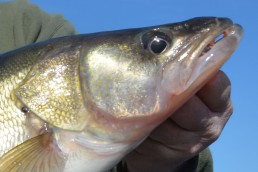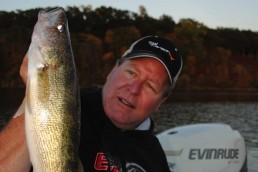November Winds mean Big River Walleyes
SHARE THIS POST
Even though many anglers have decided to put their boats away, there are many of us—myself included—who keep fishing throughout November and beyond if conditions are right to launch our boat. Now this late-season fishing is done mainly on the bigger river systems in the Midwest: the Mississippi, Wisconsin and Illinois rivers. The particular fish we are looking for are the huge walleyes available to the late-season anglers willing to chase them.
But one thing is for sure: This time of the year can produce some cold, windy fishing days.
You see folks, the predominant winds now are from the North. These stronger winds come with the troughs from Canada. You can bet on November bringing cold front after cold front. The upside? You can use these winds to your advantage when searching out those big walleyes on the rivers. For most anglers, these strong fall winds are regarded as a real nuisance. But for the walleye angler in the know, it’s a sign that it’s a time for some great fishing to be enjoyed.
It’s important to understand that windy conditions can be the walleye’s friend. When they encounter these conditions, they can become aggressive feeders. In late fall, these fish are in a feeding frenzy getting ready for the long winter. This is especially true in rivers where the rocky, slow tapering shorelines drop off into the deep water. Also, areas like flat tapering long points that reach out into the main body of water are excellent spots to start your search for these aggressive fish.
The reason that we want to concentrate on these areas during windy conditions is that when the wind is blowing either into them or across the area, small baitfish and other small species the walleyes feed on will be pushed into those areas by the wind. When this happens, it becomes a real “buffet” for the walleyes. These smaller fish will have a tendency to become disoriented in the churning waters of the area and become easy prey.
Now here is where the problem comes in:
Many anglers find fishing these rough-water conditions difficult. Precise boat control and holding your position are critical. You have to remember you’re in shallow water for the most part, and by not holding your proper position you can not only spook the walleyes from the area, but also find yourself striking the rocks with the bottom of your boat.
If you’re really not experienced at good boat control, don’t worry. There is a solution. You can anchor just off the area you intend to fish and make long casts into the fish holding areas. Make sure you have enough anchor line so that you can adjust the angle for a steeper angle on the actual anchor line. This will help ensure a good hook-up with the bottom. Work the area over completely with those jigs.
For folks more confident in your boat-control skills, here is your chance to shine.
You’re going to want to start out fishing some small jigs in the 1/16- to 1/8-ounce weight range. Tip it with a nice lively minnow in the 2- to 3-inch sized range. This weight range of jig has proven to work well when fishing these windswept areas used by feeding walleyes. This is especially true if the water depth does not exceed 6 to 8 feet or so. Also, use a thin diameter line in the 6- to 8-pound-test range.
Keep in mind, the heavier you go in jig size, the faster your jig will fall through the water. When fishing these shallow conditions, you’re actually going to want as slow a fall rate as possible. Again, start light and work your way heavier, only if necessary.
Are you enjoying this post?
You can be among the first to get the latest info on where to go, what to use and how to use it!
Many worry about what color they should use. In fall and into early winter, you’ll find that you can do much better by using either bright colors like white or yellow, or by using natural colors, like silver and black that match the forage in the area you are fishing.
Over the years I have found that you can get excellent results by using a plain, unpainted lead head jig. This unpainted jig has a resemblance to a natural forage minnow that the walleyes would feed on.
One last style of lure that works is the simple hair jig. The hair jig will catch a lot of fish year ‘round, but in the fall it is a real killer. It’s hard to beat a nice white, fluffy hair jig that’s cast out over the rocky, windswept areas. I tie my own jigs and you will always find a large assortment of hair jigs in my boat. The reason? They just plain work.
When you finally decide on an area to fish that has what your looking for—waves blowing across a point or into a rocky shore—it’s important to make your presentation correctly.
Probably the most used method by anglers is to cast. Casting an area allows you to work over every nook and cranny in the structure. Look for areas such as cuts and current breaks. Walleyes will use these areas to hide from the current and as an ambush point for baitfish.
When casting into these shallow water areas, make it a point to keep your rod higher than you normally would while making your retrieve. You want to keep a steeper angle on your line, which will help you avoid snags. Now keep in mind, you still will get snagged on occasion, but this steep angle will help you immensely.
When making your casts, try and vary the depth at which you work your lure until you find the depth that the fish are feeding at. The walleyes may be cruising the area anywhere between the surface and the bottom, so make sure you cover all depths.
It’s really pretty simple. When the winds of November and early winter are blowing, there are many walleyes to be caught. Go out on your favorite river and fish the types of areas we talked about and you’ll be amazed.
Email your outdoors questions to Mike Cyze at: lastcast13@yahoo.com.You can also check out his Blog at: lastcastoutdoors.com or listen to him on ESPN Radio.
MWO
SHARE THIS POST
Did you enjoy this post?
You can be among the first to get the latest info on where to go, what to use and how to use it!
Mike Cyze
Mike Cyze has been called one of the most knowledgeable multispecies river anglers in the country. His ability to catch fish under the challenging conditions encountered in the river environment, combined with his overall fishing knowledge, has earned him recognition as a true Mississippi River Expert. Contact him at: lastcast13@yahoo.com.



